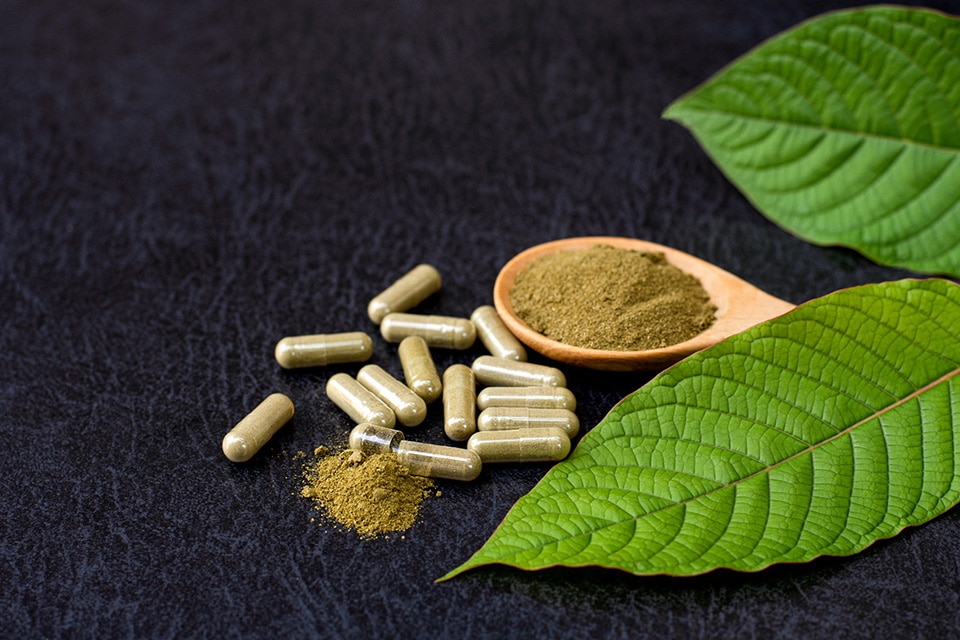Kratom is an herbal supplement that has become increasingly popular in the United States for energy, pain relief, or even managing opioid withdrawal. Sold in gas stations, smoke shops, and online, kratom is often promoted as a “safe and natural” alternative to prescription medications. But appearances can be misleading. The FDA recently alerted the public to the increasing dangers of these substances, and CMS can help.
What is Kratom?
Kratom (Mitragyna speciosa) is a plant native to Southeast Asia. Its leaves contain multiple active compounds, the most important being mitragynine. Once consumed, the body metabolizes mitragynine into 7-hydroxymitragynine (7-OH)—a substance that binds strongly to the brain’s opioid receptors.
Kratom comes from an evergreen tree in the coffee family. People typically use the dried leaf as a tea or powder or take it in capsules and concentrated extracts. While the plant contains dozens of alkaloids, mitragynine is the most abundant in raw leaf. 7-OH occurs naturally in much smaller amounts but has much stronger opioid activity once formed in the body.
Effects can vary by dose and product. At lower doses, some people report stimulant-like effects such as increased alertness or energy, while at higher doses, kratom can produce opioid-like effects. Because 7-OH engages the same receptors as opioids, kratom carries similar risks.
Why Is 7-OH So Dangerous?
7-hydroxymitragynine is far more potent than mitragynine itself. Because of this, kratom use carries real risks:
- Addiction: Kratom and 7-OH can lead to physical dependence and compulsive use. People may find themselves needing more and more to get the same effect.
- Withdrawal Symptoms: Stopping kratom suddenly can cause anxiety, restlessness, insomnia, sweating, irritability, and intense cravings, much like opioid withdrawal.
- Health Risks: While overdoses are less common than with fentanyl or heroin, kratom-related poisonings and deaths have been reported, especially when combined with alcohol, benzodiazepines, or prescription opioids.
- Unregulated Products: Kratom sales in the U.S. are not standardized. Some powders, capsules, and extracts may be contaminated or much stronger than advertised.
Is Kratom Safe?
The short answer is no. Just because kratom comes from a plant doesn’t mean it’s safe. Nicotine, cocaine, and heroin are also plant-derived. Kratom’s opioid-like effects, driven by 7-OH, can lead to serious health consequences and addiction.
Kratom is not FDA-approved to treat any medical condition, and the agency has repeatedly warned consumers about serious risks like liver injury, seizures, and the development of a substance use disorder. There are no legally marketed drug products or dietary supplements that contain kratom, mitragynine, or 7-OH.
Product quality is another concern. Testing has found some kratom products contaminated with heavy metals (lead and nickel) and others tied to Salmonella outbreaks, real risks that have nothing to do with the plant’s intended effects. Poison centers are also seeing rising exposure calls involving kratom and 7-OH, many of which require treatment in a health care facility and some that result in serious outcomes.
Kratom can also interact with common medications. Mitragynine has been shown to inhibit drug-metabolizing enzymes (notable CYP2D6 and CYP3A), which can raise levels of certain prescriptions like antidepressants or antipsychotics and increase the risk of toxicity.
Signs of Kratom Addiction
You or someone you know may be struggling with kratom dependence if you notice:
- Needing higher doses to feel the same effect
- Feeling unable to cut back or stop
- Withdrawal symptoms when missing a dose
- Spending significant time or money on kratom
- Negative impacts on work, school, or relationships
Treatment for Kratom Addiction: MOUD Works
The good news is that kratom addiction is treatable. The same approach proven effective for opioid use disorder—Medication for Opioid Use Disorder (MOUD)—can help with kratom dependence as well.
Because kratom’s main effects come from opioid-receptor activity (primarily via 7-OH), using FDA-approved medications for OUD is a logical, evidence-informed strategy. Medications such as buprenorphine, methadone, and naltrexone can:
- Ease withdrawal symptoms
- Reduce cravings
- Support long-term recovery
When combined with counseling and support services, MOUD offers one of the most effective paths to overcoming kratom and 7-OH dependence. Community Medical Services can tailor a treatment plan based on your goals, health history, and the type/amount of kratom you’ve been using to help you achieve long-term recovery.
Get Kratom Addiction Treatment at Community Medical Services
Kratom is often marketed as a harmless herbal supplement, but its active metabolite, 7-hydroxymitragynine, acts powerfully on the brain’s opioid receptors. This means that kratom is addictive, can cause withdrawal, and poses real health risks.
Luckily, medication-assisted treatment can help. If you or a loved one is struggling with kratom use, know that help is available. Effective treatments like MOUD can make recovery possible and restore health and stability. To get support for kratom addiction, contact our compassionate providers today.












